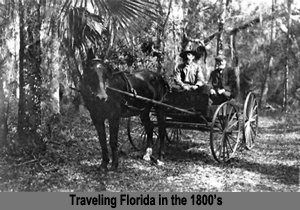The Constitution of 1838, drawn up when Florida was still a Territory, announced the government’s intention to become a state, saying that Florida was to be “…divided into four circuits, Western, Middle, Eastern and Southern, and for each Circuit there shall be appointed a Judge, who shall after his appointment, reside in the Circuit for which he has been appointed, and shall, at stated times, receive for his services a salary of not less than two thousand dollars per annum, which shall not be diminished during the continuance of such Judge in office…”
Because of the distances between the counties, and the reluctance of some judges to travel, the Constitution stated that each circuit must hold court in each county of the circuit at least twice a year, for the Spring and Fall terms, called "Terms of Court." These terms and the actual list of the counties in the circuits changed as populations grew and shifted.

Early legislation provided for a separate Supreme Court. The judges of the four circuits that existed at the time--the Western, Middle, Eastern and Southern Circuits--were initially named Justices of the Supreme Court, and served from 1846 to 1851. The first Chief Justice was Thomas Douglas, who presided over the Eastern Circuit which included Orange County at the time. The Justices received a $2,000 annual salary, but also had to pay for their own expenses, travel and supplies.

Being named a Justice didn’t get you out of riding the circuit. The four Justices still had to travel by horse or carriage to the major cities of the state; the hardship and expense of those travels discouraged many qualified men from seeking judgeships. If you lived in the northern part of the state, along with the majority of the population, it wasn’t so bad; but for people in the far south of Florida, it was a different story especially if your jurisdiction included the Florida Keys.
"The Weekly Floridian reminded the public that as far as the Southern Circuit was concerned, a judge in time must become a practical sailor, and egad, a bold one: for many is the man who would face a cannon or meet his particular friend at ten paces, without the slightest tremor of nerves, but would still falter and hesitate at making a trip to Key West, in a sailboat with an inexperienced crew. Finally, the critic recommended that the Legislative Assembly appropriate money for life preservers, instead of a law library, and clothe judges in Indian rubber rather than ermine."
In 1851, acts were passed that gave the Supreme Court a Chief Justice and two Associate Justices, separate from the Circuit Judges, and elected by the Legislature.